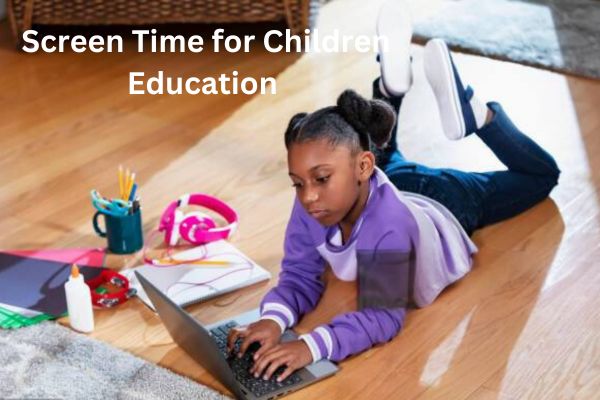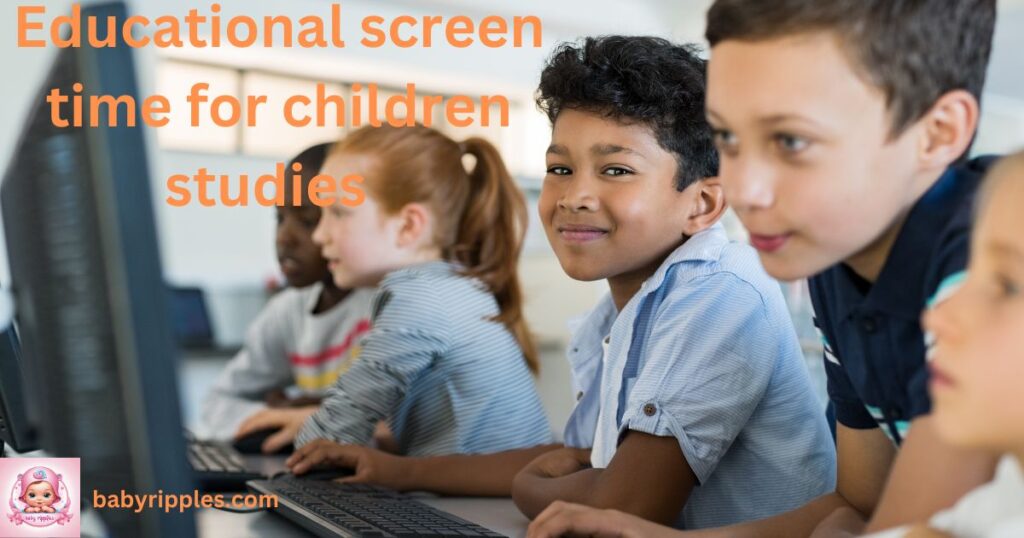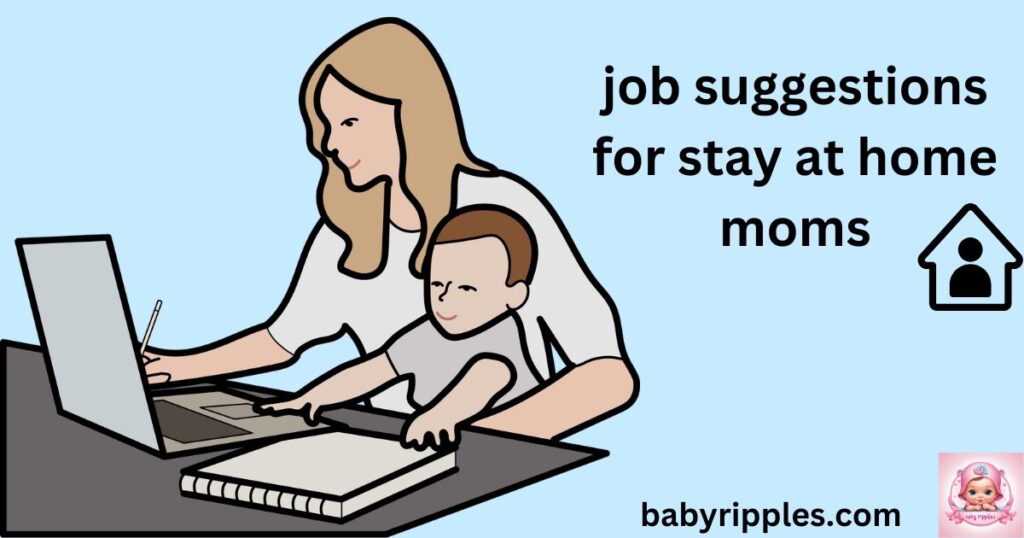One of the most talked-about issues in modern parenting is controlling kids’ educational screen time. Parents frequently struggle to strike the correct balance between preventing excessive screen time and utilizing technology to improve learning. This article explores research on educational screen time for children studies, outlines the benefits and drawbacks, and provides helpful tips to assist parents make sure their children use screens in a positive and healthy way.
- Understanding Educational Screen Time for Children
- Why Screen Time for Children Education Matters
- How Much Educational Screen Time Is Healthy?
- .Step-by-Step Guide to Effective Educational Screen Time
- Common Concerns About Educational Screen Time
- Key Benefits of Educational Screen Time
- Tips to Make Educational Screen Time Effective
- Final Thoughts on Educational Screen Time for Children
- Frequently Asked Questions about educational screen time for children studies
Understanding Educational Screen Time for Children
The term “educational screen time” describes how much time kids spend using screens—like TVs, laptops, or tablets—for educational objectives. This can involve watching educational films, taking part in virtual classes, or utilizing apps that teach language, math, or science. Educational screen time, as opposed to recreational screen time, is intended to promote academic and cognitive growth.
Why Screen Time for Children Education Matters

Technology is an integral part of today’s educational landscape. Many schools incorporate devices and apps into their curricula to enhance learning. When used effectively, educational screen time for children can:
- Improve Engagement: Interactive educational apps make learning fun and engaging.
- Provide Access to Resources: Digital tools can bridge gaps, offering children access to global knowledge.
- Personalize Learning: Adaptive apps cater to a child’s individual learning pace and style.
- Build Technological Literacy: Early exposure prepares kids for a tech-driven world.
How Much Educational Screen Time Is Healthy?
The American Academy of Pediatrics (AAP) recommends that screen time should be age-appropriate:
| Age Group | AAP Recommendations |
| Under 18 months | – Avoid screen time entirely, except for video calls with family and loved ones, which can help foster social connections. |
| 18–24 months | – If parents choose to introduce screen time, it should consist of high-quality, age-appropriate content. Parents should co-view and engage with their children during use. |
| 2–5 years | – Limit screen time to 1 hour per day of high-quality programming. Parents should co-view, helping children understand and apply what they learn. |
| 6–12 years | – Set consistent daily limits on screen use, ensuring a balance between educational, recreational, and physical activities like outdoor play and hobbies. |
| 13–18 years | – Create personalized screen time rules that align with academic needs and family values. Encourage teens to prioritize face-to-face interactions and physical activities. |
.Step-by-Step Guide to Effective Educational Screen Time

1. Choose the Right Content
Not all screen time is created equal. Look for apps, websites, and videos specifically tailored to enhance learning. Ensure the content:
- Is age-appropriate.
- Comes from reliable sources.
- Aligns with educational goals.
Pro Tip: Check reviews and recommendations for apps promoting screen time for children education .
2. Set Clear Boundaries
Define when and where screens can be used for educational purposes.
- Establish a daily schedule that includes educational screen time for children studies .
- Avoid allowing screen use during meals or before bedtime to minimize negative effects on health and sleep.
3. Use Parental Controls
Utilize built-in controls on devices to:
- Block non-educational content.
- Set timers to automatically limit usage.
- Monitor your child’s activity to ensure they stick to educational apps.
4. Encourage Interaction
Interactive screen time is more beneficial than passive viewing.
- Engage with your child by discussing the content they’re consuming.
- Ask questions to reinforce learning and ensure comprehension.
5. Balance Screen Time With Offline Activities
Even when it’s educational screen time, kids need a well-rounded routine.
- Incorporate outdoor play, reading, and social interaction into their daily schedules.
- Practice what you preach by setting an example with your own screen use.
6. Invest in High-Quality Tools
The right tools can make a big difference in ensuring productive educational screen time for children. Consider investing in:
- Blue light-blocking glasses to reduce eye strain.
- Devices with parental controls and kid-friendly interfaces.
- Subscription-based educational platforms for structured learning.
Common Concerns About Educational Screen Time

1. Is Screen Time Harmful to a Child’s Development?
Excessive screen time can lead to issues like reduced attention span or poor sleep. However, moderate and well-monitored educational screen time for children is beneficial and can support developmental milestones.
2. What About Screen Addiction?
While prolonged exposure may lead to dependency, setting clear rules and incorporating alternative activities can prevent over-reliance on screens.
Key Benefits of Educational Screen Time
- Enhanced Learning Opportunities: Access to apps and videos that promote critical thinking and creativity.
- Increased Motivation: Gamified learning can encourage children to engage with challenging topics.
- Global Exposure: Children can learn about cultures, languages, and perspectives beyond their immediate environment.
Tips to Make Educational Screen Time Effective
- Use rewards: Motivate your child to complete lessons by offering small incentives.
- Combine methods: Supplement digital learning with hands-on activities or worksheets.
- Monitor regularly: Evaluate progress and adjust the approach as needed.
Final Thoughts on Educational Screen Time for Children
If managed effectively, educational screen time for children studies can be a powerful learning and development aid. By creating clear standards, choosing appropriate content, and finding a balance with offline activities, parents can make sure their children benefit from technology. Setting limits and keeping an eye on usage are crucial for optimizing the benefits of screens, per research on educational screen time for kids. Purchasing dependable materials, getting involved in your child’s education, and utilizing technology to further their growth are all ways to improve their education.
Frequently Asked Questions about educational screen time for children studies
1. What is educational screen time?
Educational screen time refers to time spent using screens for learning purposes, such as engaging with apps, websites, or videos designed to enhance knowledge and skills.
2. How much screen time is too much?
For young children, anything beyond 1–2 hours daily can be excessive. Balance is key—ensure that screens do not replace physical activity, sleep, or face-to-face interactions.
3. Are educational apps better than books?
Both have their merits. Educational apps are interactive and adaptive, while books improve focus and imagination. A mix of both is ideal.
4. Can educational screen time harm eyesight?
Prolonged exposure may cause digital eye strain. Encourage frequent breaks and provide screens with appropriate brightness settings to reduce strain.
5. How can I ensure my child benefits from screen time?
Choose age-appropriate and high-quality educational content. Actively engage with your child during and after their screen time to reinforce learning.





